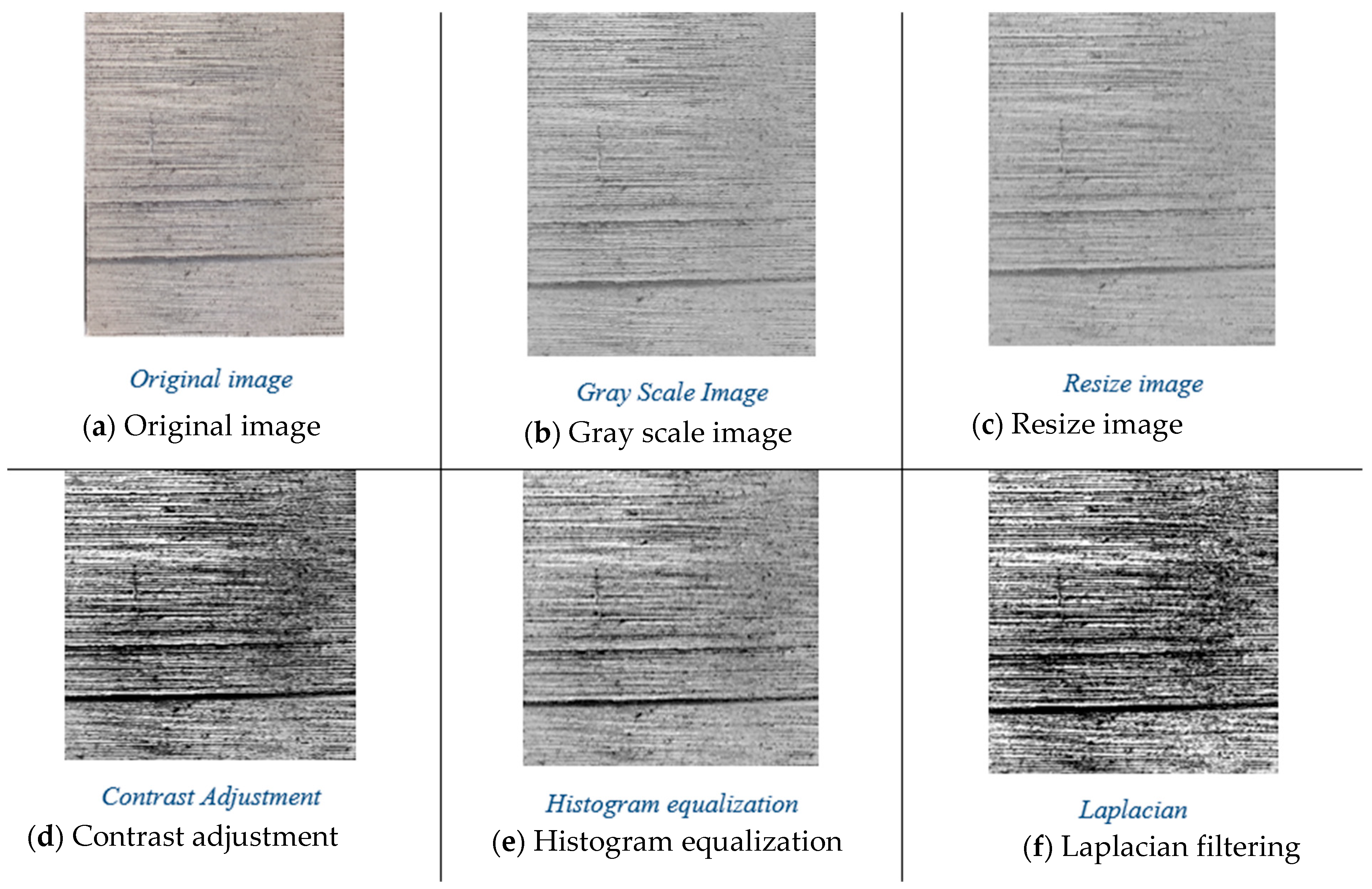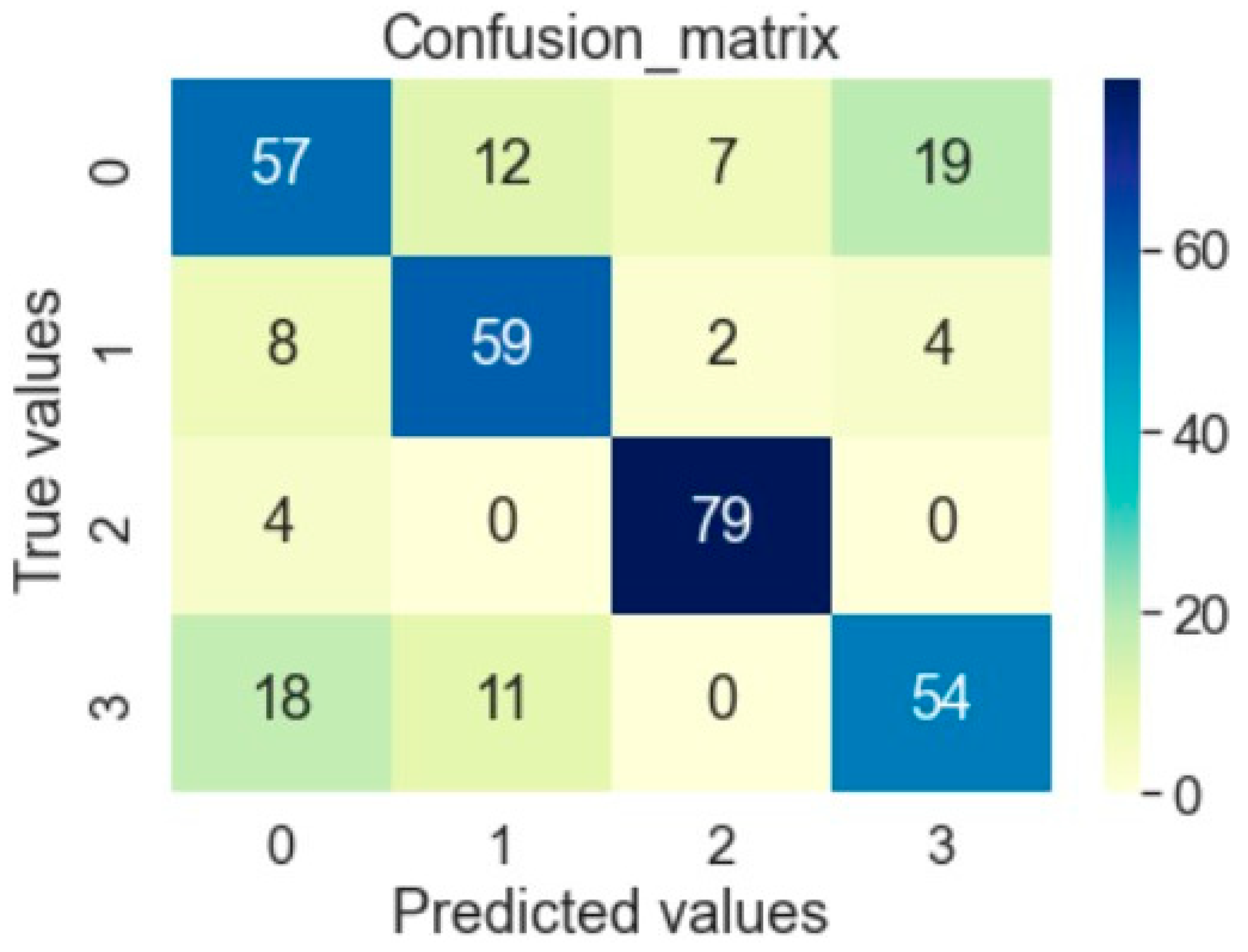Feasibility Analysis of Tamura Features in the Identification of Machined Surface Images Using Machine Learning and Image Processing Techniques †
Abstract
:1. Introduction
- -
- Using image acquisition tools to import the image;
- -
- Examining and modifying the image;
- -
- Outputting from image analysis that can potentially provide changed images or reports.
Tamura Textural Features
2. Methodology
3. Results and Discussion
4. Conclusions
Author Contributions
Funding
Institutional Review Board Statement
Informed Consent Statement
Data Availability Statement
Conflicts of Interest
References
- Ashour, M.W.; Khalid, F.; Halin, A.A.; Abdullah, L.N. Machining process classification using PCA reduced histogram features and the Support Vector Machine. In Proceedings of the IEEE 2015 IEEE International Conference on Signal and Image Processing Applications (ICSIPA), Kuala Lumpur, Malaysia, 19–21 October 2015. [Google Scholar] [CrossRef]
- Haralick, R.M.; Dinstein, I.; Shanmugam, K. Textural features for image classification. IEEE Trans. Syst. Man. Cybern. 1973, 3, 610–621. [Google Scholar] [CrossRef]
- Manish, R.; Venkatesh, A.; Ashok, S.D. Machine vision based image processing techniques for surface finish and defect inspection in a grinding process. Mater. Today Proc. 2018, 5, 12792–12802. [Google Scholar] [CrossRef]
- Dutta, S.; Pal, S.K.; Mukhopadhyay, S.; Sen, R. Application of digital image processing in tool condition monitoring: A review. CIRP J. Manuf. Sci. Technol. 2013, 6, 212–232. [Google Scholar] [CrossRef]
- Dutta, S.; Pal, S.K.; Sen, R. Digital Image Processing in Machining. In Modern Mechanical Engineering-Research, Development, and Education; Davim, P.J., Ed.; Springer Nature: Berlin/Heidelberg, Germany, 2014; pp. 369–412. [Google Scholar]
- Jurevicius, M.; Skeivalas, J.; Urbanavicius, R. Analysis of surface roughness parameters digital image identification. Measurement 2014, 56, 81–87. [Google Scholar] [CrossRef]
- Simunovic, G.; Svalina, I.; Simunovic, K.; Saric, T.; Havrlisan, S.; Vukelic, D. Surface roughness assessing based on digital image features. Adv. Prod. Eng. Manag. 2016, 11, 93–104. [Google Scholar] [CrossRef]
- Barges, E.; Thabet, E. GLDM and Tamura features based KNN and particle swarm optimization for automatic diabetic retinopathy recognition system. Multimed. Tools Appl. 2023, 82, 271–295. [Google Scholar] [CrossRef]
- Penumuru, D.P.; Muthuswamy, S.; Karumbu, P. Identification and classification of materials using machine vision and machine learning in the context of industry 4.0. J. Intell. Manuf. 2020, 31, 1229–1241. [Google Scholar] [CrossRef]
- Wang, J.; Yan, J.; Li, C.; Gao, R.X.; Zhao, R. Deep heterogeneous GRU model for predictive analytics in smart manufacturing: Application to tool wear prediction. Comput. Ind. 2019, 111, 1–14. [Google Scholar] [CrossRef]
- Vishwanatha, J.S.; Srinivasa Pai, P. Modelling and prediction of surface roughness in Ti-6Al-4V turned surfaces: Use of DTCWT image fusion and GLCM. In Proceedings of the International Conference on Advances in Manufacturing, Materials and Energy Engineering (ICon MMEE 2018), Moodbidri, Karnataka, India, 2–3 March 2018. [Google Scholar] [CrossRef]
- Lakshmana Kumar, S.; Thenmozhi, M.; Bommi, R.M.; Ezilarasan, C.; Sivaraman, V.; Palani, S. Surface roughness evaluation in turning of Nimonic C263 super alloy using 2D DWT histogram equalization. J. Nanomater. 2022, 2022, 9378487. [Google Scholar] [CrossRef]
- Joshi, K.; Patil, B. Prediction of Surface Roughness by Machine Vision using Principal Components based Regression Analysis. Procedia Comput. Sci. 2020, 167, 382–391. [Google Scholar] [CrossRef]
- Ge, J.; Liu, H.; Yang, S.; Lan, J. Laser Cleaning Surface Roughness Estimation Using Enhanced GLCM Feature and IPSO-SVR. Photonics 2022, 9, 510. [Google Scholar] [CrossRef]
- Rifai, A.P.; Aoyama, H.; Tho, N.H.; Dawal, S.Z.; Masruroh, N.A. Evaluation of turned and milled surfaces roughness using convolutional neural network. Measurement 2020, 161, 107860. [Google Scholar] [CrossRef]
- El Kadi, H. Modeling the mechanical behavior of fiber-reinforced polymeric composite materials using artificial neural networks—A review. Compos. Struct. 2006, 73, 1–23. [Google Scholar] [CrossRef]
- Mohanraj, T.; Yerchuru, J.; Krishnan, H.; Nithin Aravind, R.S.; Yameni, R. Development of tool condition monitoring system in end milling process using wavelet features and Hoelder’s exponent with machine learning algorithms. Meas. J. Int. Meas. Confed. 2021, 173, 108671. [Google Scholar] [CrossRef]
- Uddin, S.; Haque, I.; Lu, H.; Moni, M.A.; Gide, E. Comparative performance analysis of K-nearest neighbour (KNN) algorithm and its different variants for disease prediction. Sci. Rep. 2022, 12, 6256. [Google Scholar] [CrossRef] [PubMed]
- Tavus, B.; Kocaman, S.; Gokceoglu, C. Flood damage assessment with Sentinel-1 and Sentinel-2 data after Sardoba dam break with GLCM features and Random Forest method. Sci. Total Environ. 2022, 816, 151585. [Google Scholar] [CrossRef] [PubMed]
- Vijay, G.S.; Kumar, H.S.; Srinivasa, P.P.; Sriram, N.S.; Rao, R.B.K.N. Evaluation of effectiveness of wavelet based denoising schemes using ANN and SVM for bearing condition classification. Comput. Intell. Neurosci. 2012, 2012, 582453. [Google Scholar] [CrossRef]




| Feature | Definition |
|---|---|
| Coarseness | |
| Contrast | |
| Directionality | |
| Roughness | Coarseness + contrast |
| Model | Hyperparameters |
|---|---|
| ANN | Hidden layers: Two Layer 1 and 2: 100 and 50 neurons apiece optimizer: rmsprop |
| DT | Criterion: entropy, max_features:auto, splitter:best |
| KNN | Algorithm: auto, n_neighbors: 9, weights: distance |
| RF | Criterion: entropy, max_features: log2, n_estimators: 200 |
| SVM | C: 17, gamma: scale, kernel: rbf |
| Model | Training Accuracy | Testing Accuracy |
|---|---|---|
| ANN | 76.5 | 73 |
| DT | 90 | 76.6 |
| KNN | 89.50 | 76.6 |
| RF | 90 | 77.5 |
| SVM | 69.8 | 69.4 |
Disclaimer/Publisher’s Note: The statements, opinions and data contained in all publications are solely those of the individual author(s) and contributor(s) and not of MDPI and/or the editor(s). MDPI and/or the editor(s) disclaim responsibility for any injury to people or property resulting from any ideas, methods, instructions or products referred to in the content. |
© 2023 by the authors. Licensee MDPI, Basel, Switzerland. This article is an open access article distributed under the terms and conditions of the Creative Commons Attribution (CC BY) license (https://creativecommons.org/licenses/by/4.0/).
Share and Cite
Kamath, R.C.; Vijay, G.S.; Prasad, G.; Rao, P.K.; Shetty, U.K.; Parameshwaran, G.; Shenoy, A.; Shetty, P. Feasibility Analysis of Tamura Features in the Identification of Machined Surface Images Using Machine Learning and Image Processing Techniques. Eng. Proc. 2023, 59, 92. https://doi.org/10.3390/engproc2023059092
Kamath RC, Vijay GS, Prasad G, Rao PK, Shetty UK, Parameshwaran G, Shenoy A, Shetty P. Feasibility Analysis of Tamura Features in the Identification of Machined Surface Images Using Machine Learning and Image Processing Techniques. Engineering Proceedings. 2023; 59(1):92. https://doi.org/10.3390/engproc2023059092
Chicago/Turabian StyleKamath, Raghavendra C., G. S. Vijay, Ganesha Prasad, P. Krishnananda Rao, Uday Kumar Shetty, Gautham Parameshwaran, Aniket Shenoy, and Prithvi Shetty. 2023. "Feasibility Analysis of Tamura Features in the Identification of Machined Surface Images Using Machine Learning and Image Processing Techniques" Engineering Proceedings 59, no. 1: 92. https://doi.org/10.3390/engproc2023059092






